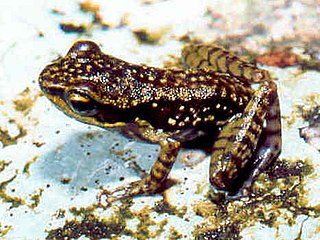
The Microhylidae, commonly known as narrow-mouthed frogs, are a geographically widespread family of frogs. The 683 species are in 57 genera and 11 subfamilies.

Cophylinae is a subfamily of microhylid frogs endemic to Madagascar. It has over 100 species in eight genera. Members of this subfamily range from minute to fairly large, and they are highly ecologically diverse. DNA barcode research has revealed a significant taxonomic gap in this subfamily, and an estimated 70+ candidate species were identified. Many of these have subsequently been described, as well as numerous new discoveries.

Cophyla is a genus of microhylid frogs endemic to Madagascar.

Plethodontohyla is a genus of microhylid frogs endemic to Madagascar.

Stumpffia is a genus of microhylid frogs that are endemic to Madagascar. They are mostly brown frogs that typically live among leaf litter. S. contumelia has a snout–vent length of about 8–9 mm (0.31–0.35 in), making it one of the world's smallest frogs, and several others in the genus are only slightly larger. The largest species is no more than 28 mm (1.1 in).

Mantidactylus is a frog genus in the mantellid subfamily Mantellinae. This genus is restricted to Madagascar. The genus is divided into several subgenera that form monophyletic genetic clusters and are ecologically similar.

Boophis is the only genus in the mantellid frog subfamily Boophinae. They are commonly known as bright-eyed or skeleton frogs. They show typical 'tree frog' traits, and are a good example of convergent evolution with morphologically similar species in the families Hylidae and Rhacophoridae, among others. This genus can only be found on Madagascar and Mayotte Island (Comoros).

Spinomantis aglavei is a species of frog in the mantellid subfamily Mantellinae, endemic to Madagascar.

Blommersia blommersae is a species of frog in the family Mantellidae. It is endemic to east-central Madagascar. Both the generic and specific names honour Rose Marie Antoinette Blommers-Schlösser, a Dutch herpetologist and entomologist who collected the type series. Common name Moramanga Madagascar frog has been proposed for it.

Spinomantis peraccae is a species of frog in the mantellid subfamily Mantellinae. It is endemic to Madagascar and widely distributed in the northern, eastern, and central parts of the island. The specific epithet honours Italian herpetologist Mario Giacinto Peracca. Common name Peracca's Madagascar frog has been coined for it.

Rhombophryne is a genus of microhylid frogs endemic to Madagascar. It is currently estimated to include more than 23 species, but only 20 of these are currently described. The common name 'diamond frog' has been proposed and used for members of this genus.

Anilany helenae is a species of frog in the microyhlid subfamily Cophylinae. It is the only species in the monotypic genus Anilany, and is endemic to central Madagascar.

Gephyromantis is a frog genus in the mantellid subfamily Mantellinae. This genus is restricted to Madagascar. At present it contains 45 species divided into six subgenera.

Guibemantis is a frog genus in the mantellid subfamily Mantellinae. This genus is restricted to Madagascar. At present it contains 25 species divided into two subgenera.

Rhombophryne coudreaui is a species of frog in the family Microhylidae. It is endemic to northeastern Madagascar. The specific name coudreaui honours Jean Coudreau, a colonial forestry administrator in Madagascar who collected the holotype. Common names Coudreau's frog and Betampona digging frog have been coined for it.

Rhombophryne serratopalpebrosa is a species of frog of the Madagascar endemic microhylid subfamily Cophylinae. Genetic evidence revealed that it is a species complex, in need of resolution. This work has made significant progress, and five related species have been described from this complex between 2014 and 2017. It is threatened by habitat loss.

Spinomantis bertini is a species of frog in the mantellid subfamily Mantellinae, endemic to Madagascar.

Spinomantis guibei is a species of frog in the Mantellid subfamily Mantellinae, endemic to Madagascar.
Spinomantis microtis is a species of frog in the Mantellid subfamily Mantellinae, endemic to Madagascar.

Rhombophryne botabota is a medium-sized species of frogs of the Madagascar endemic microhylid subfamily Cophylinae. It is found in the montane rainforests of northern Madagascar. It was described in 2016 from seven specimens.




















